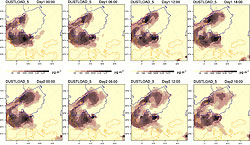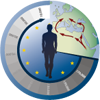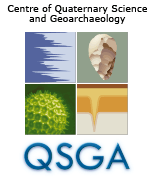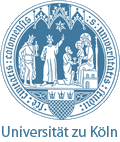One of the aims of Project E6 is to reconstruct the climate conditions related to mineral dust over Europe in the LGM. We use the regional WRF (Weather Research and Forecasting) model to simulate various representative episodes of the LGM, identified using the circulation weather type analysis.
Here, the evolution of an individual dust event is shown. Model initial and boundary conditions have been carefully specified. For instance, vegetation cover in Central Europe then was likely much lower today and south of the Fennoscandian ice sheet was most likely bare ground. The yellow line represents the extended LGM coastline that is markedly different from the present day coastline. For example, the landmass of Great Britain, an island today, was part of continental Europe during the LGM. The extent of sea ice and ice sheets is contoured by the blue line. The area depicted in a gradient of brownish colours illustrates the amount of mineral dust (dust load) emitted in the domain and transported by wind.
The eight panels show the temporal evolution of the dust event over two days with a time step of 6 hours. For Central Europe the mineral dust was transported during this event mainly by easterly winds maintained by a glacial anticyclone.
 Simulation of a dust event over Europe during the LGM. Simulation of a dust event over Europe during the LGM.Figure: Erik Jan Schaffernicht |








